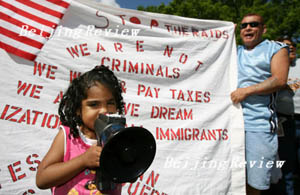
A nation of immigrants, the United States braced for a nationwide boycott May 1 by, ironically, the latest newcomers to its shores. The Statue of Liberty still proclaims at its base, "Give me your tired, your poor, your huddled masses yearning to breathe free," but in reality the nation is no longer so poetically idealistic toward immigration.
On May 1, immigrants from coast to coast left their jobs and took to the streets in protest of laws they feel are suffocating them. They called for amnesty on behalf of undocumented workers (many of whom are Latino immigrants), protested tightened border security and specifically against a bill in the U.S. Congress that, if passed, would make it a felony to be an illegal immigrant. The bill, known as HR4437, was passed by the U.S. House of Representatives, but has yet to make it through the Senate, which along with the U.S. president's signature, is required for it to become law.
Organizers of the protests called for immigrants to leave their places of work on May 1 to show how vulnerable the nation is economically without them. Yet because immigrants themselves were divided over boycotting jobs that afford many improved lifestyles, the economic impact appeared to be minimal.
Their efforts arguably demonstrated at least their symbolic importance in local economies without causing national economic chaos.
"All across the United States, we kept the pressure on; that was the goal," said Jesse Diaz, assistant member of the March 25th Coalition, which spearheaded the boycott from its base in Los Angeles. The May boycott was just one in a series of recent immigrant rights rallies, which drew 500,000 people in Los Angeles alone on the day of the Coalition launch.
Diaz, speaking amid the laughing cacophony of fellow organizers, boasted about the protesters' might a day earlier. "In essence we shut down Los Angeles yesterday," said Diaz, who claimed that 99 percent of warehouse employees, for example, didn't show up for work there. "What it showed was that without [immigrant labor] there would be no U.S. economy."
Other observers close to the issue suggested the boycott may have raised awareness about the plight of immigrants, but had a minimal impact on the economy.
"I think [the economic impact] was less than we had feared," said John Gay, Senior Vice President for Government Affairs and Public Policy at the National Restaurant Association. "We did get scattered reports of restaurants closed or those that had to curtail services."
Restaurants often employ immigrant workers who frequently are without legal status in the United States as a source of cheap labor. They potentially could have been the businesses most affected by the protest, which was dubbed, "The Great American Boycott 2006: A Day Without Immigrants."
But John Keeley, who works in Washington as director of communications for the Center for Immigration Studies, said he also heard no reports of wholesale industries being shut down.
"There was one sandwich shop on K Street that closed for the day, which meant we had 26 others to choose from," Keeley said. "It seemed to me to be a nice pleasant spring Monday in Washington."
Only about a million protesters took to the streets nationally, well below the millions forecast to rise up in certain cities alone, said Keeley, whose organization actually opposes illegal immigration as well as congressional bills that would help to legalize them. Diaz disputed Keeley's figures, saying tens of millions protested nationally.
Maria Vasquez didn't boycott though. The Arlington, Virginia, condominium janitor from El Salvador and the four other Hispanics working in her building didn't walk off their jobs, although she supports immigrant rights and attended an April rally in Washington.
"We do the work that others don't," said Vasquez, showing off her 59-year-old hands hardened by fresh calluses from mopping.
A more impartial observer of the May boycott was Rakesh Kochhar, Associate Director for Research at the Washington-based Pew Hispanic Center, which seeks to improve understanding about U.S. Hispanics without taking positions on policy issues.
Kochhar, an economist, said turnout was considered to be about a million—perhaps a little more, although he noted exact figures are impossible to obtain.
But Kochhar said essentially what occurred during the boycott was a redistribution of output, so if one restaurant was forced to close, its business on that day went to another restaurant. In other cases, companies could have rescheduled labor to be performed on another day.
The Dow Jones Industrial Average, an index of significant stocks and a U.S. economic indicator, closed on the day of the boycott slightly down by 23.85 points, or 0.21 percent, to 11,343.29.
"So nationally speaking, from the economy's point of view, this is not something of any significance," said Kochhar, who acknowledged there could have been more pronounced regional economic effects where many Hispanics reside and work, as in California. "The main effect was raising awareness, political or symbolic."
While Kochhar's economic analysis diverged from Diaz's, both touched on the symbolic value of the movement.
"Jackson Hole, Wyoming, had its first immigrant rights march ever in the state's history," Diaz said. "That tells you this movement is moving and we're not going to stop until we meet our goals and meet our demands."
In the final analysis, The Great American Boycott 2006 was nothing like America's Great Crash of 1929 of the stock market, which led to the equally dissimilar Great Depression. But many businesses did experience a day without immigrant labor.
Whether that translates into greater political clout for U.S. immigrants remains to be seen.
(Reporting from Washington)
| .jpg)
.jpg)